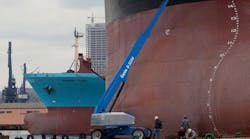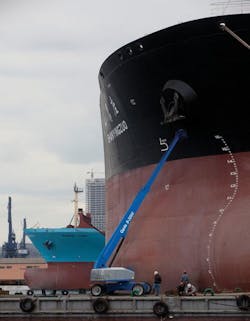Shipbuilding can wreak havoc on hydraulic systems. It occurs ocean side, so saltwater spray poses a daily threat to the corrosion resistance of piston rods in hydraulic cylinders. But a greater threat comes from spatter and other debris generated by welding operations. Welding occurs throughout the construction of ships, and welders seldom have the luxury of standing on solid ground. Instead, they may be perched atop a telescoping lift. These lifts are also used for other assembly and painting, but welding poses the greatest threat to hydraulic systems because the debris can cause premature failure of cylinders and hoses. And even if it doesn’t damage the cylinder itself, debris that adheres to a moist piston rod can quickly accumulate inside the hydraulic system to cause component malfunctions.
Terex Aerial Work Platforms (AWP) recently introduced its new Genie S-3200 and S-3800 telescopic booms to meet the demands of the Asian shipbuilding market. The Genie brand booms are being manufactured at Terex’s new AWP factory in Changzhou, China. “Our new booms, customized for harsh environments such as shipbuilding, are just the beginning of our strategy to serve the Asian market with engineered products to meet specific needs,” said XS Koo, Asia Pacific VP of Terex AWP.
Salt air, heavy oxidation, weld slag, cutting debris, and constant usage make the shipyard one of the harshest environments for a boom lift. “The Genie booms were designed specifically to address these demands, and the result is a product that offers superior performance in this type of application,” said Frank Schneider, Senior Product Manager. The booms will be used for manufacturing, repairing, and refurbishing ships, primarily targeting medium to large shipyards with boom extensions from 60 to 120 ft.
Enclosed cable and hose tracks are mounted on top of the boom to withstand the rigors of typical shipyard usage and prevent impact damage common in the shipyard. Steel covers prevent damage to hoses and cable, and all exterior hoses and cables have fire-resistant sleeves. The shipyard modifications include a complete hostile environment kit: cylinder bellows, boom wiper seals, turntable shield, ring gear guard, and air pre-cleaner are all intended to reduce the damage caused by weld slag and debris.
“We designed this product based on customer feedback, with serviceability in mind,” said Schneider. “Higher reliability and greater convenience with less maintenance means more up-time and productivity.”


